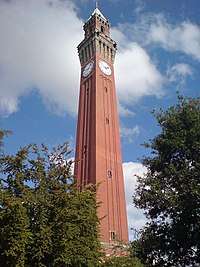Birmingham Archaeology
Birmingham Archaeology (formerly Birmingham University Field Archaeology Unit (BUFAU)) is the commercial arm of the Institute of Archaeology and Antiquity at the University of Birmingham.[1] Birmingham University Field Archaeology Unit was founded in 1976 under its founder-director Martin Carver.[2] Birmingham Archaeology closed down in 2011, although a small computer GIS unit still remains.
In its current guise Birmingham Archaeology comprises three distinct teams; Birmingham Archaeology Heritage Services, the Visual and Spatial Technology Centre (VISTA) and Birmingham Archaeo-Environmental (BAE). Each of the groups is responsible for the undertaking of commercial projects and services, the development of research projects and the delivery of postgraduate and professional training via taught Masters programmes and CPD workshops.
In 2009, Birmingham Archeology was co-responsible for the archaeological recovery of the Staffordshire Hoard, the largest hoard of Anglo-Saxon gold ever found.[3]
References
- "The difficulties of digging up files". The Times Higher Education Supplement. 2005-11-04. p. 55. Retrieved 2009-09-27.
- Buteux, Simon (2006). "Thirty years of Birmingham archaeology: A career in ruins" (PDF). Rosetta. 1: 41–50.
- "Huge Anglo-Saxon gold hoard found". BBC News. 2009-09-24. Retrieved 2009-09-27.
